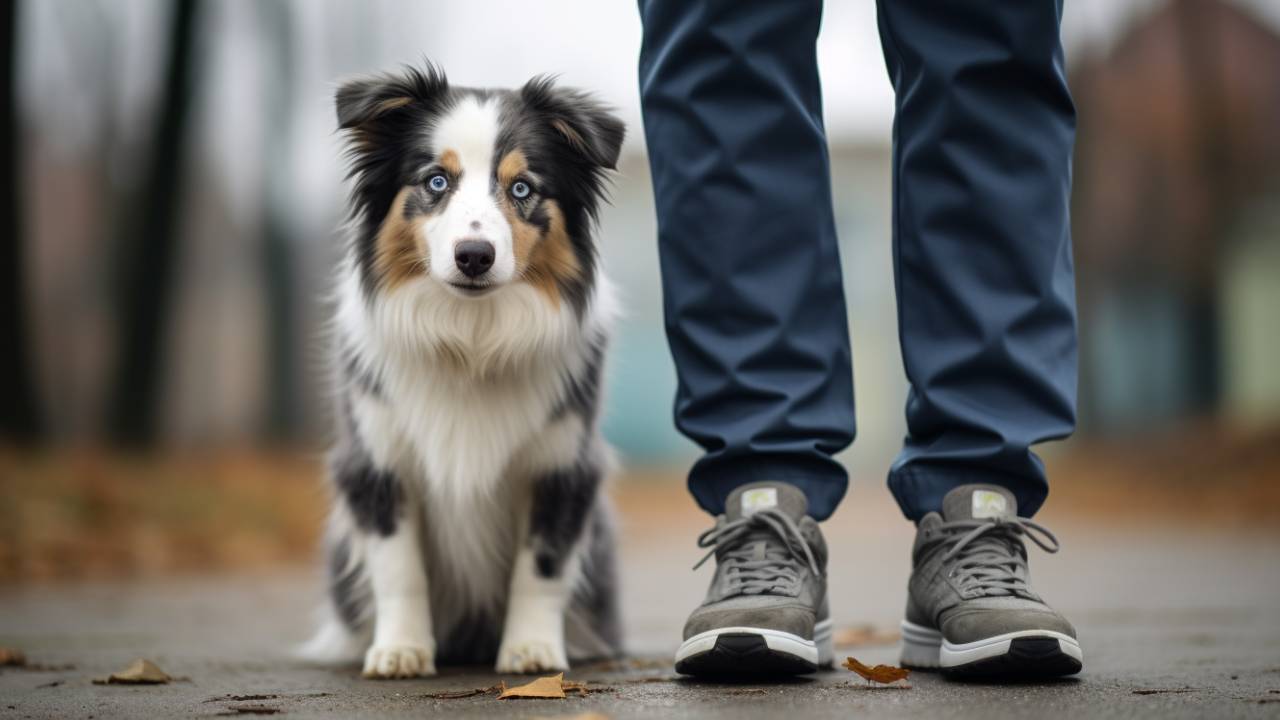The “heel” command is not just about teaching your dog to walk obediently by your side; it’s about ensuring safety and control during your walks together. When your dog heels, they walk calmly and attentively beside you, making it easier to manage them in various situations.
Whether passing by a busy street, encountering other dogs, or navigating crowded areas, having a dog that heels is valuable.
Before You Get Started Teaching Your Dog to Heel
Preparing to teach your dog invaluable healing skills begins with thorough groundwork. Here’s a closer look at what you should consider before embarking on this rewarding journey:
Proper Equipment Selection
Before you take that first step, ensure your dog is equipped with the right gear. Invest in a comfortable collar or harness that doesn’t cause discomfort or chafing.
Equally important is the leash you choose. Opt for a leash that’s neither too long nor too short; typically, a 4 to 6-foot leash works well for healing training.
The right equipment is the cornerstone of a successful training experience regarding dog heeling.
Equipment Fitting and Comfort
Once you have the necessary gear, take a moment to ensure it fits your dog snugly but comfortably. A collar should be tight enough that it won’t slip off but not so fast that it restricts your dog’s breathing or causes discomfort. Pay attention to chafing or rubbing with a harness, mainly where straps may contact the skin.
Health Check-Up
Before diving into training, having your dog’s health assessed by a veterinarian is a good idea. Ensure they are in good physical condition and free from any medical issues that might affect their ability to participate in training.
Mental and Physical Exercise
A tired dog is often a more focused and trainable dog. Make sure your pup has adequate physical exercise to release excess energy. Mental stimulation is just as important; engage your dog in activities like puzzle toys or obedience drills to keep their mind sharp. A well-exercised dog is more likely to pay attention and absorb new commands.
Set Realistic Expectations
Understand that teaching your dog to heel is a learning process that takes time and patience. Don’t expect instant perfection. Instead, set realistic goals and celebrate small victories along the way.
Be prepared for setbacks, and remember that consistency and positive reinforcement are your best allies. By taking these preparatory steps, you’ll be better equipped to embark on your journey to teach your dog to heel.

Dog Obedience Training
Before delving into the specifics of teaching your dog to heel, it’s crucial to establish a solid groundwork in basic obedience commands. These fundamental commands lay the foundation for successful healing training and contribute to your dog’s overall behavior and responsiveness. Here’s why they matter:
- Communication and Understanding: Basic commands like “sit,” “stay,” and “come” serve as a form of communication between you and your dog. When your dog understands these commands, it becomes easier to convey your expectations during healing training.
- Builds Trust and Confidence: Completing basic commands builds your dog’s trust and confidence in you. When obeying your commands leads to positive outcomes like treats, praise, or play, they become more eager to learn and cooperate in subsequent training sessions.
- Safety and Control: Basic commands also play a crucial role in ensuring your dog’s safety and the safety of others. A dog that reliably responds to commands like “stay” or “come” is less likely to engage in dangerous or unwanted behaviors, such as running into traffic or approaching unfamiliar dogs aggressively.
- Step-by-Step Progression: The skills your dog acquires through basic obedience provide a step-by-step progression toward healing. For instance, a well-trained “sit” command lets you start each healing session from a controlled, stationary position.
Add short introductory obedience training sessions to your daily routine to reinforce these foundational skills. Doing so will enhance your dog’s overall obedience and pave the way for a smoother and more successful transition into training the dog to walk beside you.
Choosing the Right Location
Start training in a quiet, low-distraction environment to set your dog up for success. Practicing in a familiar and peaceful location allows your dog to focus on learning the heel command without being overwhelmed. As your dog becomes more skilled, gradually progress to busier areas to challenge their obedience and adaptability.
How To Train Your Dog The “Heel ” Command
Teaching your dog to heel is a precise process that involves clear communication and consistent practice. To help you navigate this training successfully, here’s a breakdown of the critical steps involved in training the “heel” command:
- Preparation: Start with your dog on a leash in a quiet, distraction-free area. Have some treats or rewards ready as incentives.
- Choosing a Side: Decide which side you want your dog to heel on, typically the left. Ensure your dog knows this choice and begins on the correct side.
- Initial Position: Stand still and hold the leash in your preferred hand. Your dog should be standing or sitting beside you.
- Maintaining Position: Hold your dog’s position by your side as you walk. If your dog begins to pull ahead or lag, gently correct their position using the leash and encourage them to stay beside you.
- Use of Treats: Reward your dog with treats or praise when they successfully heel. These positive reinforcements help your dog associate healing with a positive outcome.
- Hand Signals: Alongside verbal cues, incorporate hand signals for added clarity. For example, hold your hand flat and parallel to the ground to signal your dog to stay by your side.
- Positive Reinforcement: Reinforce proper healing behavior with rewards, even as your dog becomes more proficient. Regular reinforcement maintains the demeanor.
- Real-World Applications: As your dog becomes skilled at healing, practice in different environments with increasing distractions. This prepares them for real-world situations where obedience is crucial.
- End on a Positive Note: Always end your training sessions positively, with a successful healing exercise and a reward. This leaves your dog with a positive association with the training.
You can train your dog to the “heel” command by following these steps and maintaining a consistent patient approach.
Conclusion
Teaching your dog to heel is a rewarding endeavor that enhances your bond and ensures safer and more enjoyable walks.
With the right equipment, a solid foundation in basic obedience, and consistent training in appropriate locations, you can master the art of the “heel” command. Start your training today, and watch as your dog becomes the well-behaved companion you’ve always wanted.

FAQs
How long does it take to teach a dog to heel?
The time it takes to teach a dog to heel varies depending on the dog’s age, previous training, and consistency in practice. Some dogs may learn it in a few weeks, while others may take longer. Patience and consistent exercise are essential.
Can any dog learn to heel, or is it breed-specific?
Any dog can learn to heel, regardless of breed, with proper training and patience. While some species may have a natural inclination for healing, all dogs can be taught this command.
What equipment do I need to teach my dog to heel?
You’ll need a comfortable collar or harness and a leash suitable for training. Ensuring that the equipment fits your dog correctly is essential to avoid discomfort.
How do I stop my dog from pulling while on a leash?
Teaching the heel command can help reduce pulling, encouraging your dog to walk calmly beside you. Additionally, you can use positive reinforcement techniques to reward loose-leash walking.
What should I do if my dog gets distracted during healing training?
If your dog gets distracted, return to a quieter training location and gradually introduce distractions as they become more skilled. Use higher-value rewards and maintain patience to keep their focus during training sessions.






Teaching my dog to heel has been a challenge, but your tips made a difference!